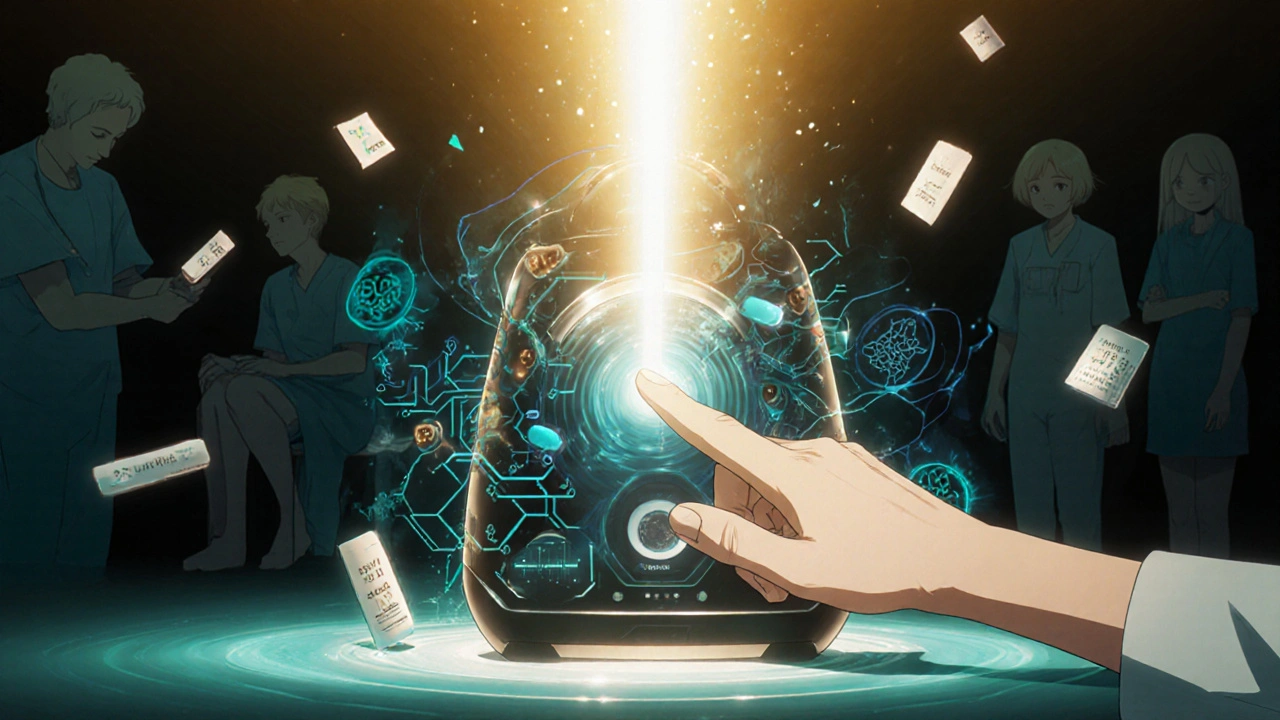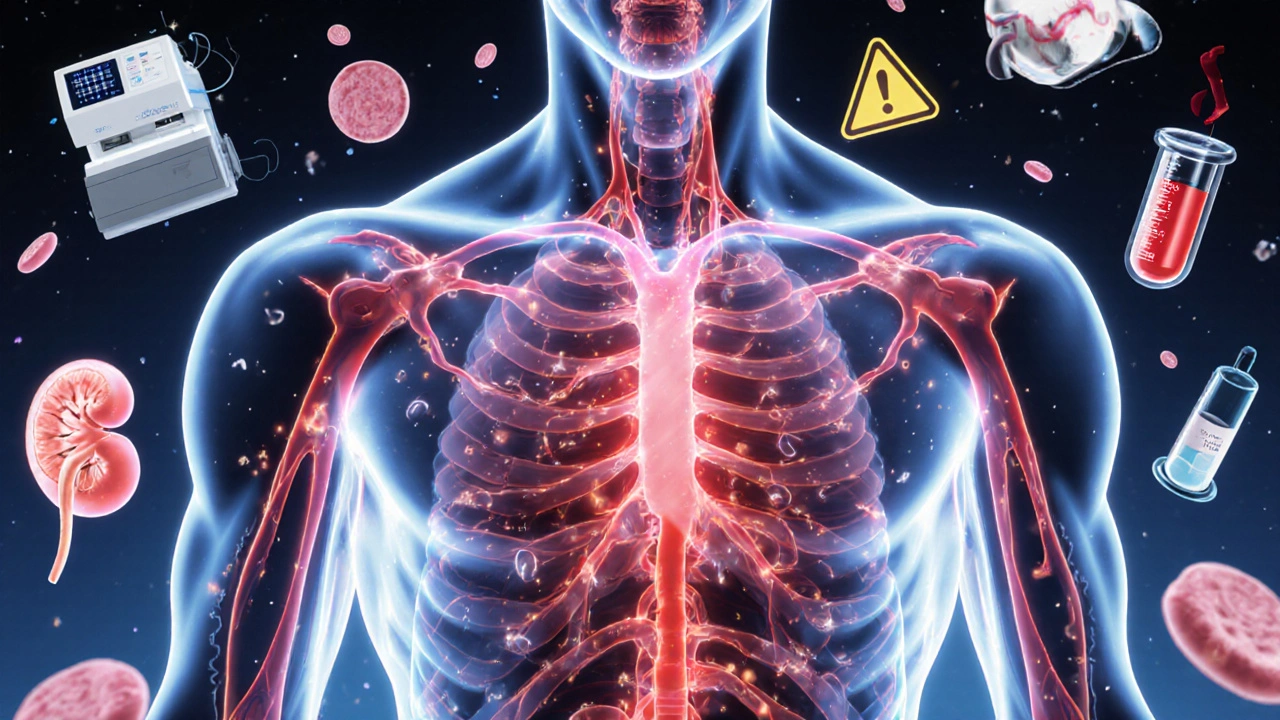Immunosuppressant Monitoring Calculator
Drug Monitoring Calculator
Results
Select your medication and enter your current level to see target ranges and next steps.
Target Range
Next Steps
Key Considerations
When you're on immunosuppressive drugs like tacrolimus, cyclosporine, or mycophenolate, your body is being carefully balanced on a knife’s edge. Too much drug, and you risk serious infections, kidney damage, or even cancer. Too little, and your body might start rejecting your new organ-or flare up your autoimmune disease. This isn’t guesswork. It’s science. And it demands regular, precise monitoring through lab tests and imaging.
Why Monitoring Isn’t Optional
Immunosuppressants aren’t like regular pills. A dose that works perfectly for one person could be toxic or useless for another-even if they weigh the same and take it at the same time. That’s because these drugs have a narrow therapeutic index. The difference between the right dose and a dangerous one is tiny. For tacrolimus, that window is just 3 to 10 ng/mL in the first few months after a transplant. Go outside that range, and your risk of rejection or kidney damage spikes.Therapeutic drug monitoring (TDM) is the backbone of safe therapy. It’s not just about checking levels once and calling it done. It’s about tracking how your body handles the drug over time. Studies show that patients who get regular TDM have 37% fewer acute rejections and 22% better five-year graft survival than those on fixed doses. That’s not a small gain. That’s life-changing.
Which Drugs Need Monitoring-and How
Not all immunosuppressants need the same kind of tracking. Some require blood tests every week. Others? Not so much.- Tacrolimus: Monitored at trough levels (just before your next dose). Target: 5-10 ng/mL early after transplant, then 3-7 ng/mL long-term. Measured with LC-MS/MS for accuracy-immunoassays can overestimate by up to 20% due to cross-reactivity with metabolites.
- Cyclosporine: Often tracked with both trough (C0) and 2-hour post-dose (C2) levels. C2 is more predictive of rejection risk. Target: 100-200 ng/mL. Higher levels mean more kidney damage.
- Sirolimus and Everolimus: Target range is 5-10 μg/L, but evidence linking levels to outcomes is weak. Still, doctors monitor because these drugs cause high cholesterol, mouth sores, and lung inflammation.
- Mycophenolic acid (MPA): Trough levels aren’t reliable. The real measure is the area under the curve (AUC) over 12 hours. AUC between 30-60 mg·h/L means an 85% chance of staying rejection-free in the first year. But AUC testing is complex and expensive-so many centers still use troughs, even if they’re imperfect.
- Corticosteroids and Belatacept: No routine TDM needed. But you still need lab checks for side effects.
Lab testing methods matter. LC-MS/MS is the gold standard-95-98% accurate, but costs $150-$250 per test. Immunoassays are cheaper ($50-$100) but can give false readings. Many hospitals still use them because of budget limits. That’s a gamble you shouldn’t have to take.
Routine Blood Work: More Than Just Drug Levels
Your doctor isn’t just watching your drug levels. They’re watching your whole body.Every 1-3 months, expect these basic tests:
- Full blood count (to catch anemia, low white cells, or low platelets)
- Creatinine and electrolytes (kidney function)
- Liver enzymes (AST, ALT, bilirubin)
- Fasting glucose (steroids and tacrolimus raise blood sugar)
- Lipids (cholesterol and triglycerides-sirolimus can push these through the roof)
- Calcium, magnesium, phosphate (cyclosporine drains magnesium-low levels cause muscle cramps and irregular heartbeats)
- Uric acid (gout risk increases with cyclosporine)
Each drug has its own red flags:
- Cyclosporine: 40-60% of patients develop low magnesium. 25% get rising creatinine-signs of kidney damage.
- Tacrolimus: 30% higher risk of new-onset diabetes than cyclosporine. Watch fasting glucose closely.
- Sirolimus: 60-75% get high cholesterol. 1-5% develop lung inflammation (pneumonitis)-a silent but dangerous side effect.
- Mycophenolate: 25-30% get low white blood cells. 30-40% get diarrhea. It’s not just an inconvenience-it can mean stopping the drug.
These aren’t just numbers. They’re early warnings. Catching a drop in platelets or a spike in creatinine early can prevent hospitalization.

Imaging: Seeing What Blood Tests Can’t
Some problems don’t show up in blood. That’s where imaging comes in.- Renal ultrasound: Done annually or when kidney function changes. Checks for blockages, scarring, or reduced blood flow-signs of chronic rejection or drug toxicity.
- Chest X-ray: If you have a cough, shortness of breath, or fever, this is the first step. Pneumonitis from sirolimus or infection from over-immunosuppression can look similar on X-ray. Sensitivity is 70-85%.
- Bone density scan (DEXA): If you’ve been on steroids for more than a year, get this annually. Steroids thin bones fast. One in three transplant patients develops osteoporosis within two years.
- CT or MRI: Reserved for suspected tumors or unusual symptoms. Long-term immunosuppression raises cancer risk-especially skin cancer and lymphoma. Routine skin checks are just as important as scans.
Imaging isn’t about finding big problems. It’s about catching small changes before they become emergencies.
The Future: TTV as an Immune Meter
The most exciting development in immunosuppression monitoring isn’t a new drug-it’s a virus you didn’t know you had.Torque Teno Virus (TTV) is harmless to healthy people. But in transplant patients, it’s everywhere. And its level in your blood tells your doctor how strong or weak your immune system is.
Here’s how it works:
- Low TTV load (<2.5 log10 copies/mL)? Your immune system is too suppressed. High risk of rejection.
- High TTV load (>3.5 log10 copies/mL)? Your immune system is too active. High risk of infection.
- Optimal range (2.5-3.5 log10)? You’re in the sweet spot.
A 2023 study showed TTV-guided therapy reduced rejection by 22% and infections by 28% compared to standard care. The TTVguideIT trial, involving 300 patients across 10 countries, is still running-but early results are strong enough that the FDA is preparing to clear commercial TTV tests by 2025.
This isn’t science fiction. It’s personalized medicine. TTV doesn’t measure drug levels. It measures your immune response. That’s the future: not just watching the drug, but watching the body’s reaction to it.

What’s Holding Monitoring Back?
Even with all this science, real-world practice is messy.A 2022 survey of 150 transplant centers found:
- 68% had inconsistent monitoring practices between departments
- Only 42% used standardized protocols for mycophenolate
- 75% said cost was the biggest barrier
- 63% lacked agreed-upon reference ranges
- 52% didn’t have enough trained staff
Patients feel it too. On average, you’ll have 12-18 blood draws in your first year. Many report anxiety, bruising, and fatigue from frequent testing. Some skip appointments because it’s too much.
But the cost of skipping? Far higher. A 2022 analysis found that full monitoring added $2,850 per patient per year-but saved $8,400 by preventing rejections, hospital stays, and emergency treatments. That’s nearly three dollars saved for every dollar spent.
What You Can Do
You’re not just a patient. You’re part of the team.- Keep a log of your drug doses, symptoms, and lab results. Bring it to every appointment.
- Ask: “What are we looking for in this test?” Don’t just accept “routine check.”
- If you’re on tacrolimus or cyclosporine, ask if your lab uses LC-MS/MS. If not, ask why.
- Report even small changes: new rash, unexplained fatigue, loose stools, tingling in hands or feet.
- Know your numbers. Don’t let your doctor be the only one who remembers them.
Monitoring isn’t about control. It’s about freedom. The right balance lets you live without constant fear of rejection or infection. It lets you go back to work, travel, play with your kids, and breathe easy.
What’s Next?
The future is faster, smarter, and less invasive. Point-of-care devices that give drug levels from a finger prick are in phase 2 trials. Exhaled breath tests for drug metabolites are being tested in labs. AI algorithms are already predicting rejection 14 days before symptoms appear-by analyzing your past drug levels, TTV, and lab trends.By 2030, the demand for immunosuppression monitoring will grow 35%, not just for transplants, but for autoimmune diseases like lupus, myasthenia gravis, and vasculitis. More people will need this care. And better tools will make it possible.
You’re not just surviving on immunosuppressants. You’re thriving-because someone’s watching the numbers, the scans, and your body’s signals. Stay involved. Stay informed. And never assume a test is just a formality. It’s your safety net.
How often do I need blood tests for tacrolimus after a kidney transplant?
In the first month after transplant, you’ll likely have blood tests 2-3 times per week. By month 3, this drops to once a week. At 6 months, most patients are tested every 2-4 weeks. After one year, if your levels are stable, testing usually occurs every 1-3 months. Your doctor will adjust based on your kidney function, side effects, and whether you’re on TTV monitoring.
Can I stop monitoring if I feel fine?
No. Many serious side effects-like early kidney damage, silent infections, or rising cancer risk-don’t cause symptoms until they’re advanced. You might feel perfectly fine while your tacrolimus level is slowly creeping into the toxic range, or your lymphocyte count is dropping. Monitoring catches these before you feel anything. Skipping tests is like driving without checking your fuel gauge.
Why is TTV monitoring not used everywhere yet?
TTV testing is still new. There’s no FDA-approved commercial test yet (expected in 2025), and labs don’t have standardized methods. Different machines give different results. Also, most insurance doesn’t cover it, and many clinics lack the staff to interpret the data. But research is moving fast. The TTVguideIT trial and upcoming TAOIST trial in France are proving its value-so adoption is growing.
Do I need imaging if my blood tests are normal?
Yes, for certain tests. Blood tests can’t see early kidney scarring, lung inflammation, or bone thinning. A renal ultrasound checks for structural damage even if creatinine is normal. A DEXA scan finds bone loss before fractures happen. These aren’t optional-they’re preventative. Think of them as annual checkups for your organs, not just your blood.
Are there alternatives to frequent blood draws?
Not yet for most drugs. But point-of-care devices for tacrolimus and cyclosporine are in clinical trials and could be available by 2026-2027. These would use a single drop of blood from a finger prick and give results in minutes. Until then, regular venous blood tests are still the most accurate method. Some centers are testing urine biomarkers, but none are validated for routine use.
What happens if my drug level is too high?
If your tacrolimus or cyclosporine level is above target, your doctor will lower your dose gradually-usually by 10-25%. They’ll retest in 3-7 days to see how your body responds. If levels stay high, they may switch you to a different drug or add a medication to help your body clear it faster. Never adjust your dose yourself. High levels can cause kidney failure, tremors, seizures, or nerve damage.
Can immunosuppressants cause cancer?
Yes. Long-term immunosuppression reduces your body’s ability to detect and destroy abnormal cells. Skin cancer (especially squamous cell carcinoma) is the most common-up to 10 times higher risk than the general population. Lymphoma and Kaposi sarcoma are rarer but serious. That’s why annual skin checks and avoiding sun exposure are critical. Your doctor should screen you regularly, especially if you’ve been on drugs for more than 5 years.



Thank you for this. I’ve been on tacrolimus for 4 years now, and this is the first time I’ve seen it all laid out so clearly. I keep a log too - symptoms, doses, labs. It helps me feel like I’m not just a number.